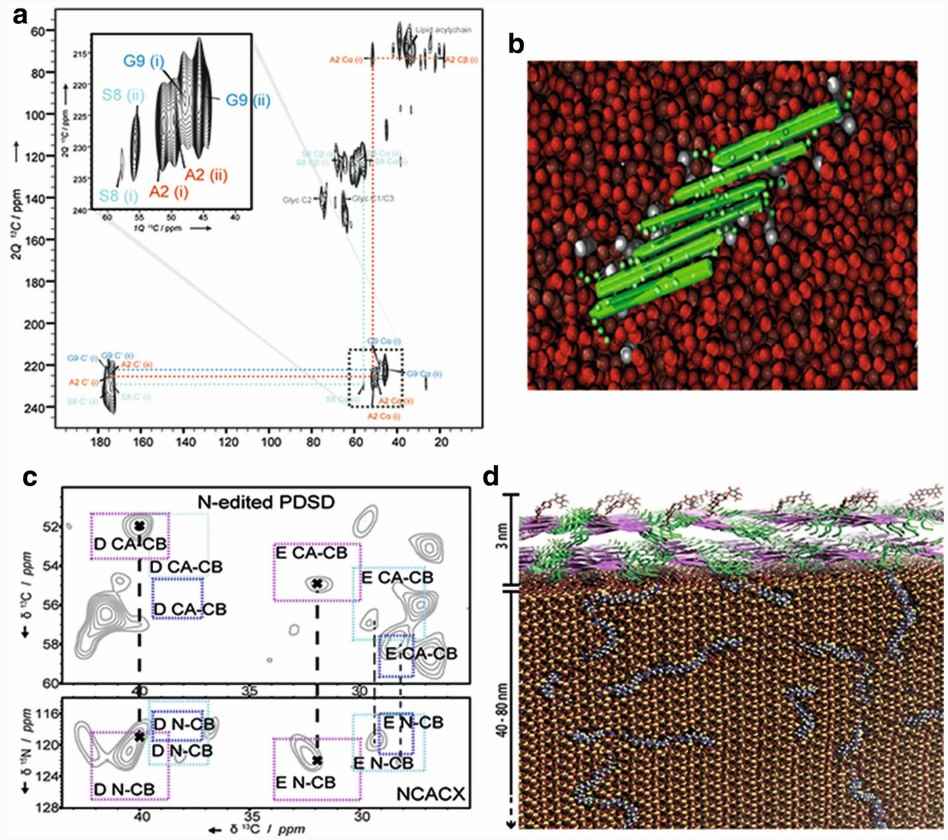Biomaterials Analysis
Solid state NMR (ssNMR) can provide the most detailed structural information, and is applicable to highly heterogeneous and complex molecular environments, which is independent of solubility or crystallinity. The combination of instrument and method improvements (including DNP and 1H detection under high-speed MAS) with advanced structure and calculation methods has greatly enhanced the applicability of ssNMR to complex molecular systems.
 Figure 1. 2D ssNMR data provide unique insight into the molecular structure of complex biomaterials such as liposomal vaccines (a, b) and diatom biosilica (c, d). (Mance et al., 2018)
Figure 1. 2D ssNMR data provide unique insight into the molecular structure of complex biomaterials such as liposomal vaccines (a, b) and diatom biosilica (c, d). (Mance et al., 2018)
As an expert in the field of nuclear magnetic resonance, Creative Biostructure, based on ssNMR technology, can provide customers with analysis services for complex biological materials such as lipid-anchored peptides, biosilicon, drug delivery systems, humins, etc.
Our Methods
Our strategy of enhancing the signal-to-noise ratio of the ssNMR study
Solid-state NMR provides more possibilities for studying complex molecular systems under "in situ" conditions. With the increase of size and molecular complexity, isotope labeling, and protein overexpression may not be sufficient to detect ssNMR signals of specific proteins in their natural biological environment. To minimize the background of ssNMR testing, our strategy includes
| Strategy | Description |
|---|---|
| Use of E. coli deletion strain | The use of E. coli deletion strains to remove the signal of natural high abundance external MP is conducive to the use of the cell envelope or whole cell of gram-negative bacteria for research. In such preparations, signals from other cellular components (including lipids, nucleotides, peptidoglycans and lipopolysaccharides) are still visible at a strength similar to that of the (overexpressed) protein of interest. |
| Adding rifampicin to the growth medium | Add rifampicin to growth medium to specifically label target protein by inhibiting the expression of endogenous protein. |
Methods to improve the spectral sensitivity of ssNMR in complex biomaterial systems
- Dynamic nuclear polarization (DNP).
- 1H detection.
- Combining ssNMR and computational approaches.
Lipid-Anchored Peptides Analysis Service
Lipid-anchored peptide materials may be used for pharmacological purposes in the treatment of neurodegenerative diseases such as Alzheimer's disease in immunotherapy-based methods. This preparation usually shows low peptide concentration, and isotope labeling for NMR research is expensive. To solve this problem, we use dynamic nuclear polarization NMR spectroscopy to provide an effective analysis service for the structural information of liposome vaccine against Alzheimer's disease.
Biosilica Analysis Service
Diatom biosilica is an inorganic/organic mixture with interesting characteristics. Up to now, the molecular structure of organic materials at the atomic and nanoscale is still unknown, especially the complete biological silica. Recently, the combination of DNP experiments with microscopy, mass spectrometry (MS) and molecular dynamics (MD) simulation provides an in-depth understanding of the structural characteristics of such systems.
Drug Delivery System Material Analysis Service
Through the integration of ssNMR measurement and large-scale and multi-scale molecular dynamics simulation, we analyze the supramolecular structure of complex peptide-based drug delivery systems for customers. When the intrinsic viscosity of the sample is close to that of soluble molecules, no isotope labeling is needed to obtain atomic insight into the supramolecular arrangement of biomaterials (such as drug delivery systems).
In our service, low MAS rate and 1H NOESY (nuclear Overhauser effect) spectrum are sufficient to detect aromatic correlation. In the case that the concentration of micelles does not require the use of MAS, we can infer the information about the intrinsic micelle core and more flexible distal segments through 1H NMR relaxation measurement.
Humins Analysis Service
Humus is a by-product of carbohydrate formed in the process of acid-catalyzed dehydration, forming a bio-based platform molecule. We provide molecular structure characterization services of humus. We apply 2D related technology to humus rich in 13C.
Creative Biostructure is committed to providing high-quality NMR analysis services to advance the life sciences fields. If you have any questions or needs, please contact us and our customer service staff will help you the first time.
Ordering Process
Reference
- Mance D, Weingarth M, Baldus M. Solid-state NMR on complex biomolecules: methods and applications. Modern Magnetic Resonance. 2018, (2): 487-503.

